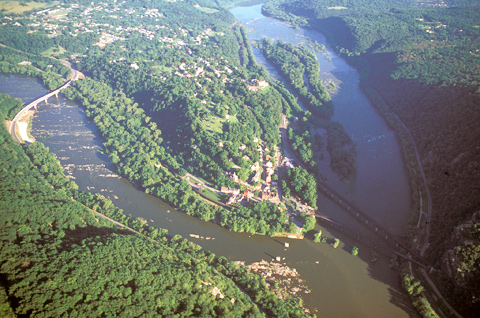In 1747 an entrepreneur named Robert Harper settled on the point of land where the Shenandoah River (left) meets the Potomac (right), and improved the ferryboat service that had been established there in 1733. Yet it was still a wilderness in the early 1780s when Thomas Jefferson wrote to a French friend, “The passage of the Patowmac through the Blue Ridge is perhaps one of the most stupendous scenes in nature.” George Washington, during his second term as president, initiated the plan that injected this needle of land deeply into the body of American history by establishing here, in 1796, the young nation’s first arsenal and armory.
In mid-March of 1803, about two weeks after Congress authorized the expedition, twenty-eight-year-old Meriwether Lewis left Washington for Harpers Ferry, where he requisitioned some rifles and the necessary appurtenances, and other supplies, including pipe-tomahawks and knives. He also supervised the construction of the iron framework for a collapsible thirty-six-foot boat, intended for a hull of animal skins, which he and Thomas Jefferson had designed. He deferentially referred to as “the Leather boat,” “the iron boat” or, in a more scientific tone, “the Experiment.” Except for that one unusual challenge for the armory’s craftsmen, Lewis’s monthlong stay was comparatively unremarkable, partly because his objectives were still shrouded in secrecy and disinformation.
Unfortunately, he didn’t have time, or simply didn’t try, to assemble the boat and test it before the expedition got under way. The first trial, which took place at the end of the eighteen-mile portage around the Great Falls of the Missouri, was the crucial one, and the last. It leaked irreparably, and wouldn’t stay afloat. Its ignominious fate was one of the more disappointing episodes in the entire story of the expedition.
Wedged between the two rocky rivers and the steep slopes of Schoolhouse Ridge, Harpers Ferry’s tiny footprint belies the richness of its roles in American history—in industrialization, in commerce, and especially in the unfolding of the Civil War and the long struggle of African-Americans out of slavery toward integration into the cultural mainstream of the “land of the free.”
From Discovering Lewis & Clark from the Air
Photography by Jim Wark
Text by Joseph Mussulman
Reproduced by permission of Mountain Press

